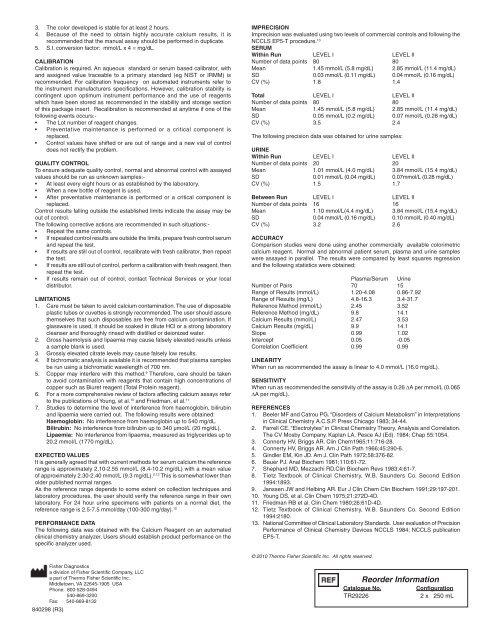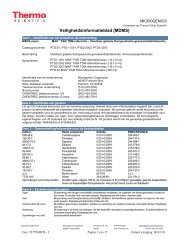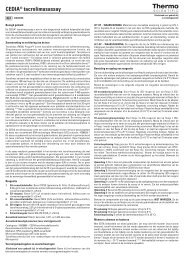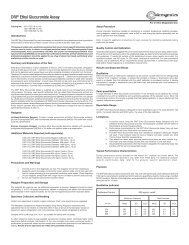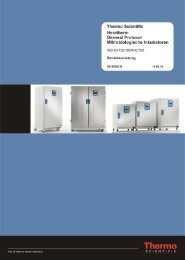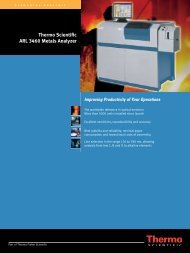Calcium Reagent - Fisher Scientific
Calcium Reagent - Fisher Scientific
Calcium Reagent - Fisher Scientific
Create successful ePaper yourself
Turn your PDF publications into a flip-book with our unique Google optimized e-Paper software.
3. The color developed is stable for at least 2 hours.<br />
4. Because of the need to obtain highly accurate calcium results, it is<br />
recommended that the manual assay should be performed in duplicate.<br />
5. S.I. conversion factor: mmol/L x 4 = mg/dL.<br />
CALIBRATION<br />
Calibration is required. An aqueous standard or serum based calibrator, with<br />
and assigned value traceable to a primary standard (eg NIST or IRMM) is<br />
recommended. For calibration frequency on automated instruments refer to<br />
the instrument manufacturers specifi cations. However, calibration stability is<br />
contingent upon optimum instrument performance and the use of reagents<br />
which have been stored as recommended in the stability and storage section<br />
of this package insert. Recalibration is recommended at anytime if one of the<br />
following events occurs:-<br />
The Lot number of reagent changes.<br />
Preventative maintenance is performed or a critical component is<br />
replaced.<br />
Control values have shifted or are out of range and a new vial of control<br />
does not rectify the problem.<br />
QUALITY CONTROL<br />
To ensure adequate quality control, normal and abnormal control with assayed<br />
values should be run as unknown samples:-<br />
At least every eight hours or as established by the laboratory.<br />
When a new bottle of reagent is used.<br />
After preventative maintenance is performed or a critical component is<br />
replaced.<br />
Control results falling outside the established limits indicate the assay may be<br />
out of control.<br />
The following corrective actions are recommended in such situations:-<br />
Repeat the same controls.<br />
If repeated control results are outside the limits, prepare fresh control serum<br />
and repeat the test.<br />
If results are still out of control, recalibrate with fresh calibrator, then repeat<br />
the test.<br />
If results are still out of control, perform a calibration with fresh reagent, then<br />
repeat the test.<br />
If results remain out of control, contact Technical Services or your local<br />
distributor.<br />
LIMITATIONS<br />
1. Care must be taken to avoid calcium contamination. The use of disposable<br />
plastic tubes or cuvettes is strongly recommended. The user should assure<br />
themselves that such disposables are free from calcium contamination. If<br />
glassware is used, it should be soaked in dilute HCl or a strong laboratory<br />
cleanser and thoroughly rinsed with distilled or deionized water.<br />
2. Gross haemolysis and lipaemia may cause falsely elevated results unless<br />
a sample blank is used.<br />
3. Grossly elevated citrate levels may cause falsely low results.<br />
4. If bichromatic analysis is available it is recommended that plasma samples<br />
be run using a bichromatic wavelength of 700 nm.<br />
5. Copper may interfere with this method. 9 Therefore, care should be taken<br />
to avoid contamination with reagents that contain high concentrations of<br />
copper such as Biuret reagent (Total Protein reagent).<br />
6. For a more comprehensive review of factors affecting calcium assays refer<br />
to the publications of Young, et al. 10 and Friedman, et al. 11<br />
7. Studies to determine the level of interference from haemoglobin, bilirubin<br />
and lipaemia were carried out. The following results were obtained:<br />
Haemoglobin: No interference from haemoglobin up to 540 mg/dL.<br />
Bilirubin: No interference from bilirubin up to 340 µmol/L (20 mg/dL).<br />
Lipaemia: No interference from lipaemia, measured as triglycerides up to<br />
20.2 mmol/L (1770 mg/dL).<br />
EXPECTED VALUES<br />
It is generally agreed that with current methods for serum calcium the reference<br />
range is approximately 2.10-2.55 mmol/L (8.4-10.2 mg/dL) with a mean value<br />
of approximately 2.30-2.40 mmol/L (9.3 mg/dL). 2,12 This is somewhat lower than<br />
older published normal ranges.<br />
As the reference range depends to some extent on collection techniques and<br />
laboratory procedures, the user should verify the reference range in their own<br />
laboratory. For 24 hour urine specimens with patients on a normal diet, the<br />
reference range is 2.5-7.5 mmol/day (100-300 mg/day). 12<br />
PERFORMANCE DATA<br />
The following data was obtained with the <strong>Calcium</strong> <strong>Reagent</strong> on an automated<br />
clinical chemistry analyzer. Users should establish product performance on the<br />
specifi c analyzer used.<br />
<strong>Fisher</strong> Diagnostics<br />
a division of <strong>Fisher</strong> Scientifi c Company, LLC<br />
a part of Thermo <strong>Fisher</strong> Scientifi c Inc.<br />
Middletown, VA 22645-1905 USA<br />
Phone: 800-528-0494<br />
540-869-3200<br />
Fax: 540-869-8132<br />
840298 (R3)<br />
IMPRECISION<br />
Imprecision was evaluated using two levels of commercial controls and following the<br />
NCCLS EP5-T procedure. 13<br />
SERUM<br />
Within Run LEVEL I LEVEL II<br />
Number of data points 80 80<br />
Mean 1.45 mmol/L (5.8 mg/dL) 2.85 mmol/L (11.4 mg/dL)<br />
SD 0.03 mmol/L (0.11 mg/dL) 0.04 mmol/L (0.16 mg/dL)<br />
CV (%) 1.8 1.4<br />
Total LEVEL I LEVEL II<br />
Number of data points 80 80<br />
Mean 1.45 mmol/L (5.8 mg/dL) 2.85 mmol/L (11.4 mg/dL)<br />
SD 0.05 mmol/L (0.2 mg/dL) 0.07 mmol/L (0.28 mg/dL)<br />
CV (%) 3.5 2.4<br />
The following precision data was obtained for urine samples:<br />
URINE<br />
Within Run LEVEL I LEVEL II<br />
Number of data points 20 20<br />
Mean 1.01 mmol/L (4.0 mg/dL) 3.84 mmol/L (15.4 mg/dL)<br />
SD 0.01 mmol/L (0.04 mg/dL) 0.07mmol/L (0.28 mg/dL)<br />
CV (%) 1.5 1.7<br />
Between Run LEVEL I LEVEL II<br />
Number of data points 16 16<br />
Mean 1.10 mmol/L(4.4 mg/dL) 3.84 mmol/L (15.4 mg/dL)<br />
SD 0.04 mmol/L (0.16 mg/dL) 0.10 mmol/L (0.40 mg/dL)<br />
CV (%) 3.2 2.6<br />
ACCURACY<br />
Comparison studies were done using another commercially available colorimetric<br />
calcium reagent. Normal and abnormal patient serum, plasma and urine samples<br />
were assayed in parallel. The results were compared by least squares regression<br />
and the following statistics were obtained:<br />
Plasma/Serum Urine<br />
Number of Pairs 70 15<br />
Range of Results (mmol/L) 1.20-4.08 0.86-7.92<br />
Range of Results (mg/L) 4.8-16.3 3.4-31.7<br />
Reference Method (mmol/L) 2.45 3.52<br />
Reference Method (mg/dL) 9.8 14.1<br />
<strong>Calcium</strong> Results (mmol/L) 2.47 3.53<br />
<strong>Calcium</strong> Results (mg/dL) 9.9 14.1<br />
Slope 0.99 1.02<br />
Intercept 0.05 -0.05<br />
Correlation Coeffi cient 0.99 0.99<br />
LINEARITY<br />
When run as recommended the assay is linear to 4.0 mmol/L (16.0 mg/dL).<br />
SENSITIVITY<br />
When run as recommended the sensitivity of the assay is 0.26 ΔA per mmol/L (0.065<br />
ΔA per mg/dL).<br />
REFERENCES<br />
1. Beeler MF and Catrou PG. “Disorders of <strong>Calcium</strong> Metabolism” in Interpretations<br />
in Clinical Chemistry A.C.S.P. Press Chicago 1983; 34-44.<br />
2. Farrell CE. “Electrolytes” in Clinical Chemistry Theory, Analysis and Correlation.<br />
The CV Mosby Company. Kaplan LA, Pesce AJ (Ed). 1984; Chap 55:1054.<br />
3. Connerty HV, Briggs AR. Clin Chem1965;11:716-28.<br />
4. Connerty HV, Briggs AR. Am J Clin Path 1966;45:290-6.<br />
5. Gindler EM, Kin JD. Am J. Clin Path 1972;58:376-82.<br />
6. Bauer PJ. Anal Biochem 1981;110:61-72.<br />
7. Shephard MD, Mezzachi RD.Clin Biochem Revs 1983;4:61-7.<br />
8. Tietz Textbook of Clinical Chemistry, W.B. Saunders Co. Second Edition<br />
1994:1893.<br />
9. Janssen JW and Helbing AR. Eur J Clin Chem Clin Biochem 1991;29:197-201.<br />
10. Young DS, et al. Clin Chem 1975;21:272D-4D.<br />
11. Friedman RB et al. Clin Chem 1980;26:61D-4D.<br />
12. Tietz Textbook of Clinical Chemistry, W.B. Saunders Co. Second Edition<br />
1994:2180.<br />
13. National Committee of Clinical Laboratory Standards. User evaluation of Precision<br />
Performance of Clinical Chemistry Devices NCCLS 1984; NCCLS publication<br />
EP5-T.<br />
© 2010 Thermo <strong>Fisher</strong> Scientifi c Inc. All rights reserved.<br />
Reorder Information<br />
Catalogue No. Confi guration<br />
TR29226 2 x 250 mL


